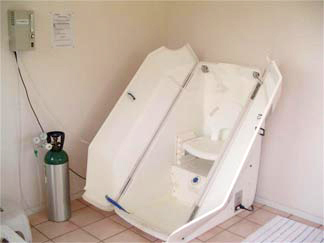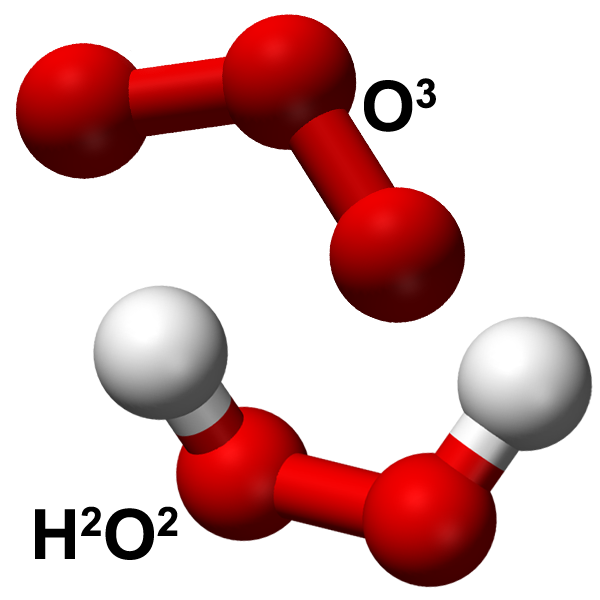How ozone therapy can increase the body’s natural oxygen burning metabolism, and how ozone in the proper therapeutic amounts also assists with jump starting the body’s antioxidant protective mechanism.
Oxygen and Energy
Did you ever sit around a campfire or a fireplace watching a fire burn when you were younger? If so, you may have been a little fascinated with the whole process. Fire is interesting. Where is all that intense heat and glowing color coming from? Well, ultimately it comes from the sun. Wait a minute…who gave the sun its energy? The tree that the firewood came from, of course, extracted elements such as carbon, hydrogen, oxygen, and nitrogen from the air, soil, and water and then used the energy of the sun to create wood, of which cellulose is a primary component. In the process of combining all these elements together into wood, the tree formed countless bonds called covalent bonds* that bind all these atoms together.

The amount of covalent bonds that are binding the atoms in a single tree together are, no doubt, mind boggling, and I won’t venture a guess as to the number in an average sized tree, but each covalent bond in that tree that is binding an atom with another atom contains a little bit of energy stored from the sun, and each time a bond is broken a little bit of the sun’s energy is released. When the wood in a tree is burning, the covalent bonds are being broken fast, and the energy is being released rapidly in the form of heat and light. To find out how all this relates to human health, let’s look at other examples of energy being extracted from the breakdown of the covalent bonds in cellulose, namely, by cellulose eating animals like cows, horses, and other grazing herbivores. Essentially, the same chemical process of energy being created from burning wood and the obvious heat and light coming from that, also allows a horse to eat the cellulose in grass and have the energy to gallop across a field.
Horses are powerful animals to be sure, yet most of their energy is coming from the breakdown of the cellulose in the grass and hay that they munch on year round. Cows and horses have the ability to both digest and then efficiently extract the energy of the covalent bonds in the cellulose contained in grass. If you have ever thrown hay out to horses you know that there isn’t much difference between wood and hay. It’s all just cellulose really; a form of carbohydrate that these animals can digest but we humans can’t. (That’s why the all hay diet has yet to catch on as the latest fad diet!) As was mentioned, just as a fire can rapidly break the energy containing covalent bonds in the cellulose of a burning forest or burning grass and create energy, the horse and many other grazing animals can break down these energy containing bonds that the grass contains in a slower, more controlled fashion. So how does all this relate to oxygen you might ask? It relates because the common denominator in these two examples of getting energy from cellulose is oxygen. Oxygen is the fundamental catalyst that drives this chemical reaction that extracts energy from cellulose. None of this can happen without oxygen. Without oxygen, fires go out, and without adequate oxygen, human and animal metabolism slows down and becomes inefficient. Oxygen is so critical to this internal “fire” of our metabolism, that without it, we die in seconds. So how do our bodies use the oxygen we inhale, and the energy contained by the covalent bonds in the food we eat to create energy?

Mitochondria: The tiny furnaces inside our cells
 Inside each of our trillions of cells, each one a complex factory in itself, are many tiny little furnaces called mitochondria.
Inside each of our trillions of cells, each one a complex factory in itself, are many tiny little furnaces called mitochondria.
They have their own membranes and their own DNA.
You may remember this from your biology classes, but let’s just say that as far as its important to human health, it is a subject that deserves revisiting.
When it comes to life and the production of energy, the mitochondria are where the rubber meets the road, so to speak.
*A covalent bond is a chemical link between two atoms in which electrons are shared between them.
These little power plants take the fatty acids from dietary fats, amino acids from protein, and glucose from carbohydrates and create the energy that all of us need to get up and go. Inside the mitochondria, these molecules from food are combusted so to speak. The complex chemistry that happens inside these mitochondria called the Krebs citric acid cycle, and the OXPHOS cycle, are the processes by which these molecules from food are systematically disassembled by enzymes in the mitochondria in a slow burn, and the covalent bonds are broken to release energy that is used to create ATP. The whole process is referred to as cell respiration. ATP or Adenosine Triphosphate, which is the energy rich molecule that all living things are powered by is the main product produced by cell respiration. The biochemistry behind all this is fascinating and is also beyond the scope of this little newsletter to dissect. In reality, unless you are a biochemistry geek who gets excited about electron transfer, and mitochondrial proton gradient research, you don’t really need to remember this basic biochemistry anyway. No doubt most who read this newsletter are mainly interested in taking practical steps to improve their health. That being the case, if there is one thing that can’t be stressed enough, it is that the oxygen utilization that goes on inside your mitochondria for the production of energy is critical to all functions that the body carries out; it is the energy needed to maintain one’s health or recover it. Here in lies the connection between this basic info about oxygen metabolism and your health.

When good mitochondria go bad
The energy needed to improve one’s health or recover it. Think about that statement for a moment.
People with chronic illness are often energy deprived. And not just energy deprived from the standpoint of “Hey I feel too tired to go to work today. I think I’ll stay home”, but no, literally energy deprived, at the cellular level.
They have an inefficient oxygen metabolism inside their mitochondria. Instead of a raging fire in the little furnaces inside their cells that creates heat and energy, they may be dealing with something more akin to a flickering fire. They have inefficient cellular energy production and all the symptoms that go with it.
Frank Shallenberger, M.D., who is considered the leading authority on ozone therapy in the United States calls this “Early Onset Mitochondrial Dysfunction” or EOMD (Shallenberger, F. 2011, p 42). This problem can be insidious. It is usually not readily apparent, but it can become a constant drain on one’s well-being. The term dysfunction indicates that this is not a natural process of aging.
The mitochondria do decay with aging, but in some individuals their measurable mitochondrial oxygen burning metabolism is far below normal for their height, age, and weight.
If you line up several people of the same age group and test them you will find significant variations in their ability to utilize oxygen. A few months ago at a Natural Health Conference in Salt Lake City, several of my friends and associates did a free resting VO2 test. This test measures the amount of oxygen going in when you inhale, and the amount of carbon dioxide coming out when you exhale, and calculates your resting oxygen metabolism. It was interesting to see the different results people were getting. On a personal level, I was very curious about my own results. Having gone through an illness in the past that involved fairly significant toxic metal poisoning and nutritional deficiencies, I was concerned that there may have been some permanent mitochondria damage that occurred. Whereas mitochondrial dysfunction as described by Shallenberger is readily reversible (with ozone), damage and decay to mitochondria can be permanent. Naturopaths don’t like to use the word permanent because of a fundamental belief in the body’s ability to heal, but realistically, some damage to the body can be permanent. That is one reason preventing and reversing oxygen usage dysfunction is so important, because left and decay of the mitochondria.
As mentioned earlier, the mitochondria have their own DNA and these cannot be repaired the way the DNA in the cell nucleus can be. I was relieved to see that the results of my own VO2 test showed above average resting oxygen usage metabolism for my height and weight. There is no doubt in my mind that eating a nutrient dense diet, taking good quality supplements, doing the required detoxification therapies to eliminate known mitochondrial toxins, and then going back to running and other aerobic types of exercise prevented mitochondrial decay that may otherwise have occurred. My use of ozone, no doubt, also factored into this as well; ozone can significantly enhance and restore mitochondrial usage of oxygen to burn calories and produce energy. Interestingly, although the VO2 test that we were voluntarily taking that day was primarily aimed at determining metabolism for weight loss reasons, it was also clear that those who were showing poor oxygen metabolism also looked unwell.
Watch Frank Shallenberger MD, HMD as he discusses the important topic of mitochondrial resuscitation through the usage of ozone.
So what’s going on? Why the variation in the ability of different individuals to use oxygen to burn fuel in their bodies? There are many things that can affect this: hormones – especially a deficiency of T3 Thyroid hormone, poor nutrition, and of course a sedentary lifestyle are some key factors. The good news is that with the assistance of oxygen therapies, and healthy lifestyle changes like nutrition and exercise, resting VO2 and VO2 max (the maximum oxygen used during exercise) can be increased. People with Chronic Fatigue, Fibromyalgia, and related health issues very often times have slow oxygen usage metabolisms due to dysfunctional mitochondria, the aforementioned EOMD. Several animal studies show that this is definitely not a good thing. Mice with early mitochondrial dysfunction that kept them from using oxygen efficiently in their metabolism, demonstrated various symptoms of premature aging and death (Trifunovic A, Wredenberg A, 2004).
Ironically, one of the consequences of EOMD is that free radical induced oxidative damage is taking place inside the mitochondria and contributing to the decline of the mitochondria. That last statement is a little interesting, because normally oxygen and antioxidant nutrients are antagonistic to one another. They are in a perpetual dance in which oxygen is grabbing electrons, and antioxidants are donating them. Since oxygen and antioxidants have differing agendas, one would assume that if oxygen utilization inside the mitochondria is weak, that these antioxidants would get the upper hand chemically, so to speak. Meaning that like a see-saw effect, there would be an excess of antioxidant activity as oxygen activity decreases. If this were the case then free radical damage inside cell mitochondria with weak oxidative “fires” would be a non-issue. This is not the case though. One must remember that the body doesn’t just take antioxidants from the diet, but also produces them endogenously, so therefore dietary antioxidant intake is not the only determining factor in a person’s antioxidant status. In the case of EOMD and the poor oxygen utilization that goes along with it, free radical oxidant damage develops right alongside the weakening oxygen utilization, and this is due in part to inadequate antioxidant production by one’s own body. In order to produce the antioxidant buffers needed to counter free radicals, the cell needs energy from the mitochondria, but with EOMD the cell is energy deprived due to poor oxygen usage that is creating a “dirty metabolic fire” that is both extremely inefficient and creates excess byproducts including…more free radicals. Therefore, a cyclical problem continues. The reduced oxidation inside the cell mitochondria, coupled with reduced production of antioxidant buffers, damages the enzymatic machinery inside the cell’s mitochondria, creating a sort of biochemical mess. In his now classic book, Doctor Stephen Levine calls this “functional hypoxia” (Levine SA, Kidd PM, 1985).
So…how is this all relevant to the sick person who wants to be well, or a healthy person who would like very much to stay that way? In the healthy cells inside healthy people, the opposing oxidation and antioxidant forces are powerful and strong. In someone sick and fatigued, these chemical reactions are typically both quite weakened. What you want to do is make them both stronger. Oxygen therapies are quite excellent at doing this.
Jump starting your oxygen metabolism
If you want more oxygen just take a deeper breath right? Actually that’s not a bad idea.
Deep breathing exercises are associated with many health benefits.
Aerobic exercise is also fantastic for increasing the speed, efficiency, and number of mitochondria. While these are extremely valuable lifestyle factors, in some cases it’s just not enough. These are great for keeping a healthy person healthy, but if one is already weakened and debilitated, they may simply be unable to exercise. Oxygen therapies like ozone on the other hand can be a stepping stone to pull the person up by their boot straps and get the energy producing mitochondria working again.

How ozone helps restore mitochondrial efficiency and oxygen usage
Ozone’s true therapeutic value is in its ability to release a singlet oxygen atom. Singlet oxygen atoms are hungry for an electron. The O2 molecule was happy because the happy couple shared an outer orbiting electron. When ozone, which is three elemental oxygen atoms in a shaky relationship, is put into the body in proper therapeutic amounts, the singlet oxygen at-oms are released and almost immediately react with the double covalent bonds of amino acids and lipids creating ozonides.
As Doctor Shallenberger explains in “Principles and Applications of Ozone therapy”, it is these ozonides, which are much more stable molecules (but also electron hungry) that increase cell respiration. It is not known, or at least I should say that I don’t know of any research showing that ozone actually crosses the plasma membrane of the cell and into the cytoplasm, and then passes the plasma membrane of the mitochondria to act directly to increase oxidation inside the mitochondria. My current knowledge and understanding says that it does not, it being too unstable. The good news is that it doesn’t have to. Many oxidizing, or electron borrowing functions in the body are carried.

What is ozone?
Ozone is three oxygen atoms that are connected together as one molecule, sharing outer electrons. The normal atmospheric oxygen is 2 atoms of oxygen together that share an orbiting electron. This latter form of oxygen is a very stable, happy couple. When an energy source such as ultraviolet light comes along and splits these two atoms apart some will rejoin with nearby O2 and create the tri-atomic ozone. The ozone molecule is much more unstable and reactive. It quickly releases one of its singlet oxygen atoms and this atom will oxidize nearby amino acids and fatty acids creating what are called ozonides. From a biological standpoint, it is the much more stable ozonides that exert the powerful therapeutic oxidizing benefits of ozone, one of which is to rev up oxygen’s metabolic use in the body.
Once the ozonides cross the membranes into the mitochondria they directly oxidize key molecules involved in cell respiration and combustion. It is not possible to discuss them all so let’s zero in on the most important one which is called Nicotinamide adenine dinucleotide, or NAD which is the oxidized form of NADH. OK you may be about ready to throw this newsletter away if you hated biochemical terms in biology, but bear with me. NAD is very important. Without it, oxygen cellular respiration would come to a halt and we would die. As Doctor
Shallenberger points out NAD is the final stage molecule in cellular energy production. It performs what the oxygen itself would perform, namely it grabs electrons from nutrients being disassembled in the mitochondria and catalysis energy release as covalent bonds are being broken. Go out and run a bit or ride a bike if you are able. It feels good huh? NAD makes it possible. It is burning that fat, sugar, or protein from your last meal.
Chemically speaking, grabbing an electron from another molecule is called oxidation, while donating an electron is called reduction. One atom is oxidized, the other is reduced. This process together is known as Redox. In the case of weakened oxidation inside the mitochondria that we earlier described as EOMD there is going to be a deficiency of NAD. NAD is so important to cellular combustion that the mitochondria try to maintain a 700 to 1 ratio of NAD to NADH. The reason why it can be difficult to maintain this ratio is that each time NAD is used in one chemical reaction in the mitochondria, it gets converted to NADH. In order to maintain the ratio just mentioned, it has to be quickly converted back to NAD and oxygen does this. In some cases, it is just not happening fast enough, thus the dysfunction. This is where ozonides come in. Once in the mitochondria, they oxidize NADH back to the potent NAD by borrowing an electron from this molecule. In a sense, the ozonides truly jump start this process and can help reverse mitochondrial dysfunction before it becomes mitochondrial decay and possibly irreversible damage. This is all very relevant to anyone wanting to lose weight or who deals with fatigue. When you increase cellular combustion, especially the oxidizing of fats while resting, weight loss will naturally result and fat will become energy. But ozone is damaging to the body some uniformed people might assert. It is a free radical, isn’t it?

Ozone as an antioxidant?
No, ozone is not an antioxidant of course, but it is also not a free radical either as some assert. What ozone does seem to do when used safely and properly is to improve overall antioxidant status. As discussed earlier, it does this in part by reducing the number of free radicals produced when a “dirty” oxygen deprived cellular combustion exists. The other way it improves antioxidant status is by increasing the body’s own production of antioxidant buffering enzymes such as catalase, S.O.D., and glutathione peroxidase. Doctor Shallenberger conducted some interesting research on a small group of AIDS patients. AIDS patients typically have reduced antioxidant buffering capability and free radical damage and these AIDS patients had measurable free radical damage. What’s really interesting is that these patients were all on mega-doses of oral antioxidant nutritional supplements, yet these supplements were failing. Doctor Shallenberger administered daily infusions of ozone. At about the 7 to 10 treatment mark, all showed marked improvement and lessening of free radical damage, and marked increase in antioxidant buffering enzymes. For a Traditional Naturopath, this is quite fascinating. In a sense the ozone was functioning as an Isopathic therapy, meaning that ozone, which is an oxidizer in vivo, decreased free radicals overall by stimulating the body’s own protective mechanisms. Even in AIDS patients with reduced vitality, this ability of their own body to produce molecules to squelch free radicals was more powerful than the antioxidant effects of herbal and other pills. Of course the antioxidant supplements helped, they were just less powerful than the body’s own antioxidant production. This is just one more example of the benefits that oxygen can have on a challenged body. Indeed ozone and other oxygen therapies can be a crucial component of recovery from a great variety of health challenges.
In Conclusion
Summing things up here, this was an explanation of a key benefit of ozone: its ability to increase oxygen metabolism and restore mitochondrial function, thus increasing available energy to all cells while also serving to increase antioxidant function. In the introduction we talked about other benefits of ozone that will be discussed in future newsletters such as its ability to kill infections and to assist with detoxification. While these certainly have therapeutic importance, in my view they are somewhat less important than the tremendous benefits that can come from increasing cellular combustion and energy production. There are plenty of natural ways to kill infections and detoxify the body, but not too many things can restore a broken oxidative metabolism in the cellular mitochondria.
Attention:
All wishing to schedule an appointment with Natural Health Sciences of Arizona, LLC. (Jack Miller) are required to become members of Desert Paths Natural Wellness Association. To become a member, please go here: DPNWA.org
Jack Miller CTN does not provide medical advice, diagnosis or treatment through this Website. The purpose of this digital publication is to explore current research and discussions of holistic natural therapies and healthy lifestyle factors that are typically not discussed in the realm of modern allopathic medicine. The content of this Digital Publication, such as text, graphics, images, and other material has not been evaluated by the FDA and is for informational purposes only. The Content is not intended to be a substitute for professional medical advice, diagnosis, or treatment. Always seek the advice of your physician or other qualified health provider with any questions you may have regarding a medical condition. Never disregard professional medical advice or delay in seeking it because of something you have read, heard or seen on this digital publication. If you schedule an appointment with Jack Miller you will be given natural therapies and supplements to support your healing, but they are not a substitute for medical treatment.


